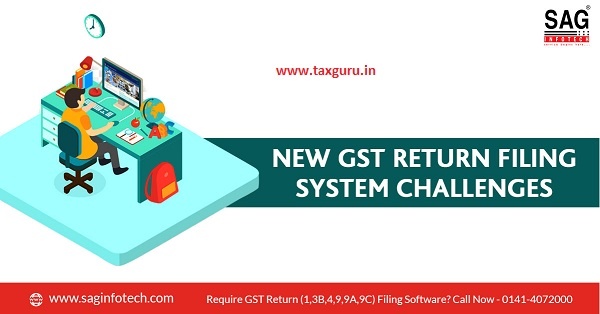In 27th GST Council Meeting, the Panel announced the implementation of a new GST return format which is believed to be a much simpler version of the current GST return. This new GST returns policy is scheduled to commence from April 2020 which aims at eradicating the flaws of the prevailing GST filing system making it more of a transparent and accurate tax compliance mechanism.
Well, it is evident that every new system carries its own set of initial challenges exposed to which are the taxpayers and the government. Cataloged below is the set of challenges which are believed to occur once the new GST return filing system is implemented:
Complications with invoice uploading – Businesses especially small businesses may face complexities related to real-time invoice uploading. Even a single invoice that is missed being uploaded on the GST portal may lead to a loss for the taxpayer while he claims an ITC for the same. Though he has a physical invoice.
For instance, the buyer (who is also a monthly tax filer) may face the risk of losing ITC if the purchase invoice is not yet uploaded by the seller (who is filing returns on a quarterly basis). Uploading the invoice immediately after the transaction is a must to avoid such drastic circumstances.

Process after the invoice is uploaded – Looking upon the existing GST filing mechanism, the GST invoice once uploaded on the portal requires no further proceedings from any of the two parties (seller or buyer). But as confined by the new GST filing system, the tax invoice uploaded will be marked as accepted/rejected/pending by the buyer.
If the invoice is accepted the ITC automatically gets credited in the account of the recipient (taxpayer) and if rejected then the recipient is bound to furnish a reversed ITC in the main return (GST RET 1). So the challenge here is the reconciliation done by the recipient and that both the parties (buyer & seller) should maintain absolute communication to avoid discrepancies. A taxpayer can opt for tools that automatically accept, reject or keep the invoice pending (owing to the situation).
To be noted: Any kind of flaw or false claim in ITC may lead to huge penalties imposed by the tax department.
Dealing with adjustment entries – According to the rising GST system, once the invoice is accepted, the ITC automatically gets credited in the electronic credit ledger of the recipient but what about ITC reversals (pending or rejected invoices)? And what if there is a partial or damaged supply recieved by the recipient? In such cases, there is no idea of how the process goes?
If the recipient files the reversed ITC in any of the above-mentioned cases then another adjustment has to be done by the recipient once he receives the credit note of the same in the next tax period otherwise he may lose the credit twice. Also, the credit is taken on a temporary basis for which the supplier has not uploaded the invoice, needs to be reversed once the supplier uploads the invoices.
Adjustment entries are submitted in a summarized form and not on an invoice basis hence the companies making frequent transactions and having loads of data need to be careful with their adjustment entries. Companies have the option of owning an electronic invoice tracking system to avoid discrepancies related to ITC reversals or unintentionally claiming false ITC.
Amendments in the company’s ERP – It is obvious that the implementation of any new GST system will lead the businesses to make necessary changes in the software used for fetching POS summary, HSN wise summary, etc. Similarly, the company’s invoicing system will undergo a transformation and will be integrated on a trial basis from the beginning of 2020.
Companies need ERPs strictly adhering to the norms and standards of the coming GST filing system so that they are away from bearing penalties for non compliance.
These are some of the immediate challenges popping up with the commencement of the new GST filing system which may bother taxpayers as well as the government. The resonance of the system may be deep and may cause other real-time complexities to the taxpayer. The only way to get through this is complete awareness and proper compliance. Hopefully, taxpayers will have enough time to prepare for the implementation of new GST return.






Thank you for sharing your knowledge and keep us updated.